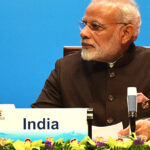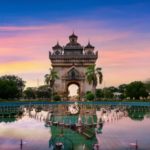Last week, Cambodian Prime Minister Hun Sen, speaking at the opening of a US$85 million amusement park funded by a Chinese company in Kandal Province (and repeated in a barely-noticed tweet), posed a simple question, “I would like to ask that, if China doesn’t build roads and bridges, who will instead?”
But although China is Cambodia’s preferred provider and perceived guarantor of domestic legitimacy, it surely isn’t the only choice. If Cambodia wanted a reasonable infrastructure development alternative to China, it already has a reliable partner in the region – Japan, although there are many caveats. The fact is that according to a Fitch Solutions survey, across Southeast Asia, Japan has invested nearly 30 percent more than China in infrastructure – US$367.8 billion against China’s projects at US$255 billion.
The two have been engaged in an investment spree across the region in the effort to win access to economic and political resources. But despite Japan’s spending, it is China, through its Belt and Road Initiative, that has taken primacy for political influence.

There is no better example than Cambodia, where Japan has enjoyed a historic relationship that began in the 1950s with the establishment of diplomatic ties. Japan saw potential in Cambodia as early as the 1980s and worked actively up until the signing of the Paris Peace Agreements in October 1991 and also assisted all of the parties in reconciliation.
In reconstruction of post-war Cambodia, Japan began a long and steady partnership with a particular emphasis on infrastructure such as roads, bridges and water systems. Through Japan’s official development branch, Japan International Cooperation Agency (JICA), Tokyo has been the largest bilateral donor to Cambodia after China for years. According to Cambodian government sources, between 1992 and 2018, Japan provided US$2.8 billion in official development assistance (ODA) for projects such as the Tsubasa Bridge, which connects Vietnam, Cambodia and Thailand, and numerous road and infrastructure projects across the country.
If Hun Sen wanted more evidence, he could point to a $US266 million loan to increase road transportation and cross-border logistics with Thailand given earlier this year, which will widen National Road No. 5, which connects the Cambodian capital of Phnom Penh and to Bangkok. Divided into three sections, the project covers 366 km from the Prek Kdam area in Kandal Province to Poipet in Banteay Meanchey Province. The loan terms are rather favorable as well. The repayment period is for 40 years, which includes a 10-year grace period and an annual interest rate of 0.01 percent.
Japan doesn’t invest in Cambodia simply out of altruism, but out of a belief that it could counter Beijing in a strategic, long-term bet on Cambodia’s economic potential. Over 30 percent of Cambodia’s population is composed of people under age 14, and nearly 18 percent are between 15 and 24. Some of that belief is based on past successes in Cambodia, evidenced by Japanese diplomacy after violence in Phnom Penh in 1998, when Tokyo brokered an agreement between Hun Sen’s Cambodia People’s Party (CPP) and the FUNCINPEC, which opened the door for Prince Norodom Rannariddh and other opposition members to return to Cambodia in time for the July 1998 election.
In the meantime, a state-owned offshoot of China’s Tianjin Province, the Union Development Group, is building the huge Dara Sakor Seashore Resort, a US$3.6 billion gambling and lifestyle project on 36,000 hectares accounting for a full 20 percent of Cambodia’s coastline in Koh Kong Province. The resort, expected to include an international airport and cruise ship terminal, which the US suspects could be a staging area to be used by the Chinese military. Union Development has been sanctioned by the US for illegally appropriating villagers’ land and other issues.
China’s massive investment and dominance in Cambodia are intimidating and put both Japan and Cambodia in more precarious positions. Tensions between China and Japan in the South China Sea put Cambodia in a predicament on how to respond when pressed, although in the past Phnom Penh has urged the two sides to work out their differences peacefully. Ultimately, Cambodia could benefit from Sino-Japanese competition with the two rivals attempting to outperform one another in infrastructure investments through the Japan-Mekong Cooperation and China’s Lancang-Mekong Cooperation.
While Japan has been one of the largest investors in Cambodia with more than 250 companies registered, it pales in comparison to China. Bilateral trade between the two countries reached US$2 billion in 2018, up from just US$366 million in 2010. One of the major barriers to increased bilateral trade and investment opportunity is poor quality infrastructure, particularly in rural areas and internet connectivity. JICA has been involved in the creation of Special Economic Zones (SEZs) in Cambodia and other Southeast Asian countries.
JICA has been interested in developing free-trade areas close to Cambodian ports and in neighboring Myanmar at the deepwater Thilawa Port. However, this economic activity has created headaches for JICA in Myanmar, as land rights are a major flashpoint for locals. Historically, this is also true for Cambodians, which have been removed from their land and stripped of titles by the Khmer Rouge—and now by real estate developers and agribusinesses. The drive to do business in Southeast Asia is tempered however, by significant and persistent sources of risk.
What should be of chief concern to Tokyo is its international image amid the ongoing authoritarian crackdown on political dissent and operating space for Cambodian civil society. Although China has a significant upper hand in Cambodia, economic possibilities and a young country with vast potential cannot take a backseat to human rights concerns. Japan cannot be caught posturing for the affections of a brutal autocratic leader. While Beijing-Phnom Penh ties grow deeper, Japan cannot afford to erode the credibility and status it has earned in the Indo-Pacific.
Hun Sen knows the answer to his own question. It can only be China. Japan or other potential infrastructure donors cannot offer the same kinds of contracts or conditions as set by Beijing. Despite all of its efforts to build bridges or boost national infrastructure capacity, only China can offer the short-term legitimacy the Hun Sen regime requires. A change of course would cause irreparable damage to Japan’s favorable image in Cambodia, whose civil society despises Hun Sen.
Japan saw some evidence of this when it gave moderate support to the 2018 Cambodian elections despite a predictable and lopsided result. When the European Parliament and most of the West condemned the dissolution of the opposition Cambodian National Rescue Party, Japan was noticeably silent. Worse, the Secretary-General of the Liberal Democratic Party (LDP), Toshihiro Nikai congratulated Hun Sen on his electoral victory. Mitsuko Shino, Japan’s Ambassador to the UN, also issued a bland statement on the outcome, noting that Japan was “paying close attention” to Cambodia and was optimistic that the 2018 election “reflect[ed] the will of the Cambodian people.”
For the foreseeable future, it will be China that finances and develops most of Cambodia’s critical infrastructure, while Japan maintains an important, yet secondary relationship. Undermining decades of impactful Japanese diplomacy—despite the unfortunate outcome—would be a tragic mistake. The stark truth is that China and Cambodia chose each other. China found a partner back in 1996 under Jiang Zemin and Hun Sen, after meeting with Chinese leadership, launched a coup in 1997, confident in the fact that China would not impose the same demands upon it as the West. Rather, Beijing boosted Cambodia’s economy with lavish amounts of aid. It has been the same ever since.






